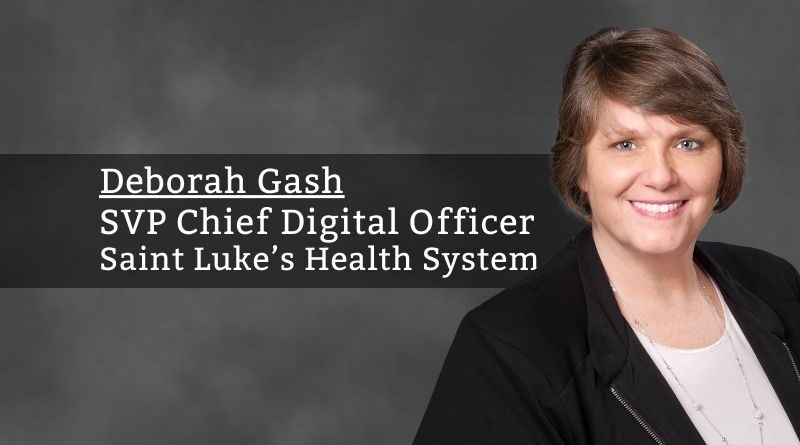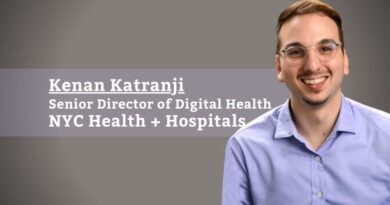The Real-time Digital Health System: Automation for Care Operations
By Deborah Gash, SVP Chief Digital Officer, Saint Luke’s Health System
As a 16-hospital, an integrated health system serving 67 counties in Missouri and Kansas, Saint Luke’s Health System has faced challenges: increased demand for care, higher patient acuity, and critical staffing shortages.
Addressing these challenges was critical to helping us achieve our vision of becoming a digital health system. As part of this, we embarked on a strategic throughput initiative to improve operational efficiency and integrate care progression across the system. We believed that if we could unlock efficiency for patients in the inpatient setting, we would create downstream capacity and improve access for new patients coming in the door.
Extending the EHR with Enterprise-wide Predictive Capabilities
Over the past few years, we have invested significantly in our Epic EHR capabilities. Our teams now use many advanced features and functionality to maximize value from the system. And as a system of record, the EHR enables our teams to capture clinical data and equips them with dashboards and insights to understand the current situation.
As we embarked on our strategic throughput initiative, we first explored how to further leverage our EHR. But even after implementing recommended enhancements, our teams were still managing patient flow from the “rearview mirror.” We used EHR throughput dashboards to set discharge goals, but these only used population averages, such as GMLOS, rather than recommending targets specific to a patient’s condition and circumstances. We also tried using EHR checklists to track discharge plans, but these created ongoing, manual documentation for our teams that still required much back-and-forth communication.
Through these activities, we realized that we needed new predictive capabilities. This system had to meet several criteria: it had to integrate with the EHR and leverage real-time patient data; it needed to automate processes wherever possible or make it easy for frontline teams to take the right action at the right time; and ultimately it had to reduce the workload for physicians and staff.
We quickly recognized that building these capabilities in-house would be too time-consuming and cost-intensive, so we decided to partner with a vendor who uses AI and ML to automate care operations. This gave us access to top data science, behavioral science, and clinical operations experts to help us operationalize AI models and maintain the technology.
We originally started working with our vendor in the early phase of the pandemic to help us with systemwide planning for COVID-19. Our work together quickly evolved to bring automation capabilities to our inpatient and perioperative settings, as well as to our systemwide command center, Central Patient Logistics.
Creating Inpatient Bed Capacity
We focused first on creating inpatient bed capacity. In the past, our teams managed care progression within the EHR, but there were so many moving pieces to discharge a patient that we experienced a lot of variabilities. To better manage throughput across the system, we needed to optimize discharge planning at the patient level.
Working alongside our vendor’s clinical and process improvement experts, we set up new multidisciplinary discharge rounds (MDRs). To reinforce these process changes, the software makes it easier for our teams to consistently establish and update discharge plans. Integrating with the EHR, it ingests patient-specific clinical data and then uses AI and ML to auto-populate or recommend key elements such as the estimated date of discharge (EDD), disposition, and likely barriers to discharge for each patient.
With the discharge plan and barriers captured during MDRs, the system automatically coordinates with ancillary services to resolve those barriers. Instead of the first-in, first-out EHR worklist used in the past, our vendor helps our ancillary services teams prioritize patients based on discharge.
The system also helps our leaders be more proactive in addressing issues in real-time. For instance, it lets them know when a patient identified as a morning discharge is still in a bed at noon so they can help remove barriers to getting that patient safely discharged.
By shifting discharge planning upstream, we have reduced excess days by 0.3 to 0.6 days per patient at two of our largest facilities. This creates a significant amount of new bed capacity to care for patients.
Unleashing Perioperative Growth
Like many health systems, we rely on surgical cases to strengthen our margins and support other services. To accommodate growing surgical demand — while having fewer available staff due to staffing shortages — we needed to maximize value on our OR schedules. The challenge was that teams continued to rely on manual processes and tools that kept a significant amount of OR time locked up.
Our perioperative team partnered with our vendor to automate surgical scheduling processes so we could unlock OR time, increase case volume, and improve utilization. ML identifies blocks unlikely to be used and then encourages surgeons and schedulers to release the time — weeks in advance. AI then automatically offers newly-released time to the specific surgeons and schedulers predicted to be the best fit, so we can strategically grow our volume instead of just filling the time with any available case. There’s also a reservation interface that surgeons and schedulers can use to view and request time — without logging into the EHR.
In the first six months using the solution, we’ve unlocked more than 170 hours, which is increasing at an accelerating rate each month as we drive greater use of the system. Blocks that would have previously gone unused are now used more than 37% of the time. In the last month alone, we had 109 cases scheduled through this system.
Improving Operational Efficiency Systemwide
With improved operational performance in inpatient and perioperative settings, we needed to optimize resources across the health system and improve care coordination between sites. Previously, we had co-located core system functions and teams in our system command center, Central Patient Logistics. However, our centralized teams still operated in a manual, reactive manner, and when exploring new approaches, we found that traditional command center technologies only replicated EHR capabilities.
To optimize our systemwide resources and processes, we realized this was another opportunity to use predictive capabilities. Our teams now have real-time situational awareness across facilities, service lines, and units. ML predicts census hours in advance, giving our teams more time for planning and decision-making. Looking ahead, the system will also help balance demand across acute care and community hospital settings.
With this foundation of predictive capabilities in place, we are far ahead today. Already, these capabilities have provided us with a distinct advantage in the market. We also see a broad range of new opportunities for care operations automation on the horizon, including integrating care delivery across new settings, such as virtual care or hospital-at-home, and optimizing staffing and scheduling.



